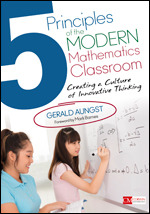5 Principles of the Modern Mathematics Classroom
Creating a Culture of Innovative Thinking
- Gerald Aungst - School District of Cheltenham Township; Elkins Park, PA
Foreword by Mark Barnes
Corwin Mathematics Series
Students pursue problems they’re curious about, not problems they’re told to solve.
Creating a math classroom filled with confident problem solvers starts by introducing challenges discovered in the real world, not by presenting a sequence of prescribed problems, says Gerald Aungst.
In this groundbreaking book, he offers a thoughtful approach for instilling a culture of learning in your classroom through five powerful, yet straightforward principles: Conjecture, Collaboration, Communication, Chaos, and Celebration.
Aungst shows you how to
- Embrace collaboration and purposeful chaos to help students engage in productive struggle, using non-routine and unsolved problems
- Put each chapter’s principles into practice through a variety of strategies, activities, and by incorporating technology tools
- Introduce substantive, lasting cultural changes in your classroom through a manageable, gradual shift in processes and behaviors
Five Principles of the Modern Mathematics Classroom offers new ideas for inspiring math students by building a more engaging and collaborative learning environment.
"Bravo! This book brings a conceptual framework for K-12 mathematics to life. As a parent and as the executive director of Edutopia, I commend Aungst for sharing his 5 principles. This is a perfect blend of inspiring and practical. Highly recommended!”Cindy Johanson, Executive Director, Edutopia
George Lucas Educational Foundation
"Aungst ignites the magic of mathematics by reminding us what makes mathematicians so passionate about their subject matter. Grounded in research, his work takes us on a journey into classrooms so that we may take away tips to put into practice today."
Erin Klein, Teacher, Speaker, and Author of Redesigning Learning Spaces
Take a look at Gerald describe why you need this book!
"One of the major strengths is that the book is written in teacher friendly language and that it gives practical examples. This content is much needed for today’s teachers who are either stuck in a traditional way of teaching OR wanting to change and are looking for ideas . . . I would definitely purchase this book and would strongly consider it as a supplementary, recommended text for classes I teach as an adjunct faculty member."
"This book is great for our educational world right now. There have been many who are talking about the changes in our math classrooms to help promote more problem solving and not just answering questions. This is a great start for teachers to begin to make changes in their classrooms for students to become great problem solvers . . . I would purchase this book for the math team to have them begin the discussions of helping students become problem solvers."
"This book is practical and forward thinking. It should be required reading for undergraduate college math methods classes."
"I absolutely recommend publication! Elementary teachers are overwhelmed with how to teach multi-step problems to young children. Knowing they (the teachers) don’t have to be the Know-All of the class, but to allow the students the opportunity to think, possibly fail, repeat, provides the teacher time to watch the students and help direct their learning.”
"Math is an area in which critical thinking skills are vital. This book will assist educators in encouraging students to think critically when dealing with math problems. Learning to incorporate the 5C’s into the math classroom is sure to enhance both teaching and learning! . . . I would purchase this book. We always welcome material that will enhance our students’ ability to learn and develop critical thinking skills! (And even have some “fun” while learning!!!)"
"In this book, Gerald Aungst expertly weaves math & literacy to promote a culture of thoughtful inquiry, problem-solving, and innovative thinking. He consistently demonstrates deep respect for the topic, the teachers, and the students, carefully interspersing stories, strategies, questions, tips, and tools in just right places throughout each chapter to maximize understanding using a gradual release of responsibility model. My eyes are forever opened to an instructional world where math and literacy not only coexist – but work in concert to elevate our instructional power potential!"
“A dynamic read for math educators K-12, Aungst challenges the status quo and many traditional methods of classroom instruction that are still prevalent in many of our nation’s classrooms. In doing so, he makes a case for the vitality of a student-centered, rich classroom culture, filled with collaboration, problem-solving, rigorous curriculum, and high-quality communication, while celebrating student success at every turn. Moving from theory to practice, and providing a myriad of concrete methods and examples, 5 Principals of the Modern Mathematics Classroom is a must-have tool for every math teacher’s professional toolbox!”
"Aungst ignites the magic of mathematics for his readers through five beautifully articulated guiding principles. Reminding us of what makes mathematicians so passionate about their subject matter, Gerald not only grounds his work in research but also takes us on a journey into several classrooms in each vignette so that we may take away actual, practical tips to put into practice today."
"Gerald has written a book about math instruction and learning, but the strategies can easily trickle to other disciplines in school. He not only shares great ideas about how we can create meaningful learning opportunities and environments for students, he clearly articulates why this is important. As someone who is not a math teacher, I found what Gerald wrote to be applicable to much of the work that I am doing in all areas, and really felt that the environment of math learning that he shared is much better than the one I experienced as a student."
"This is the book that teachers have been waiting for - evidence-based practices that are easy to implement. Aungst walks us through simple ways to change our mindset about math, encourage students to embrace mathematical challenges and integrate technology in our daily practices. So many ideas for every grade level!"

